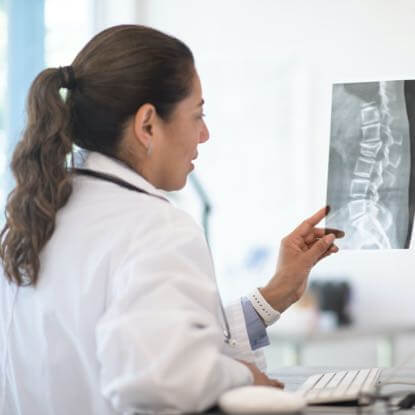At Long Island Spine Rehabilitation Medicine, we have found that many of our patients, no matter how intelligent, well-read, or highly educated, are confused by certain commonly used medical terms relative to our diagnoses and treatments of spinal and other musculoskeletal disorders. Under our assumption that a well-informed patient is more comfortable with treatment options than one who is confused, we’ve decided to answer some questions that seem to linger in the clouds of medical information (and disinformation).
What Is the Difference Between a Bone Break and a Fracture?
These two terms are interchangeable, although “fracture” is the medical term and “break” is the colloquial one. Bone fractures may be minor or severe depending on the size of the affected bone, the size of the break itself, and whether the fracture occurs at a joint.
What Is a Compound Fracture?
A compound fracture is a fracture in which there is an open wound or break in the skin at or near the site. In most cases, the wound results from a sharp fragment of bone piercing the skin.
Compound fractures are more dangerous than other bone breaks because the open wound presents a serious risk of infection.
What Is a Stress (Or Hairline) Fracture?
A stress fracture is a tiny crack in a bone caused by repetitive force, usually from overuse, such as repeated jumping or long-distance running. Most frequently, stress fractures occur in the lower leg or foot, though they may also occur in the wrist.
What Is a Compression Fracture?
Compression fractures occur in the spine, typically as a result of osteoporosis (loss of bone mass). They are usually the result of a fall, a hard cough, or the lifting of a heavy object, each of which may put excess pressure on a weakened vertebra.
What Is the Difference Between a Tendon and a Ligament?
Both tendons and ligaments are bands of muscle tissue. The basic difference is that tendons attach muscles to bone and ligaments attach bones to one another. Tendons provide support to assist movement, while ligaments provide support to stabilize joints.
What’s the Difference Between a Sprain and a Strain?
The difference between a sprain and a strain is that a sprain injures a ligament, while a strain causes damage to a tendon. Both are more severe when the tissue is not just overstretched but torn or ruptured.
What Are the Differences Between Bulging, Herniated, Slipped, and Ruptured Discs?
Discs are the cushions between the vertebrae (bones of the spine). While their outer layers are tough, their centers are soft. A bulging disc occurs when at least a quarter to a half of the disc’s circumference protrudes from its correct position. When a disc bulges, only the outer layer of cartilage is affected.
When a disc is herniated, however, some of the softer inner cartilage protrudes through a crack in the outer surface of the disc. Other terms are used for this condition, for example, “slipped” or “ruptured” discs – but are considered less accurate. Herniated discs hurt more than bulging discs because the former more commonly result in painful inflammation of the adjacent nerve root.
What Is the Difference Between Osteoarthritis and Inflammatory Arthritis?
Osteoarthritis is a degenerative process in which the cartilage (that cushions the ends of bones at the joints) wears down. Usually, this happens as a result of aging, but other disease conditions, injuries, or lifestyle factors may affect its progression. If osteoarthritis continues unabated, eventually there is no cartilage protection, and bone rubs against bone.
Inflammatory arthritis, on the other hand, is a chronic autoimmune disorder in which the immune system attacks the body’s own tissue. Types of inflammatory arthritis include rheumatoid arthritis, psoriatic arthritis, gout, lupus, and Lyme disease.
Contact Us for Customized Treatment of Any Musculoskeletal Condition
The experienced doctors at Long Island Spine Rehabilitation Medicine are well-prepared to relieve pain and restore function – no matter what your condition is called. Call us soon for an appointment and improve your quality of life without surgery.
